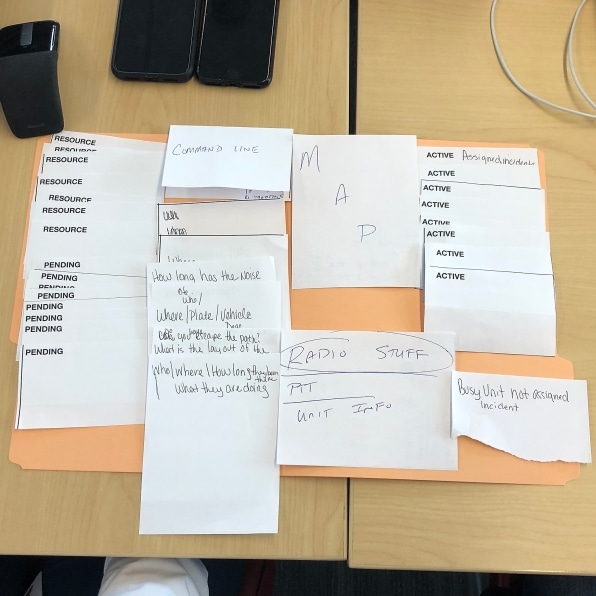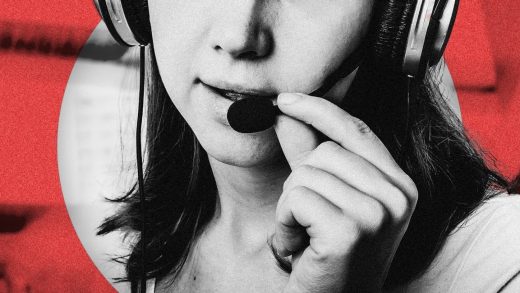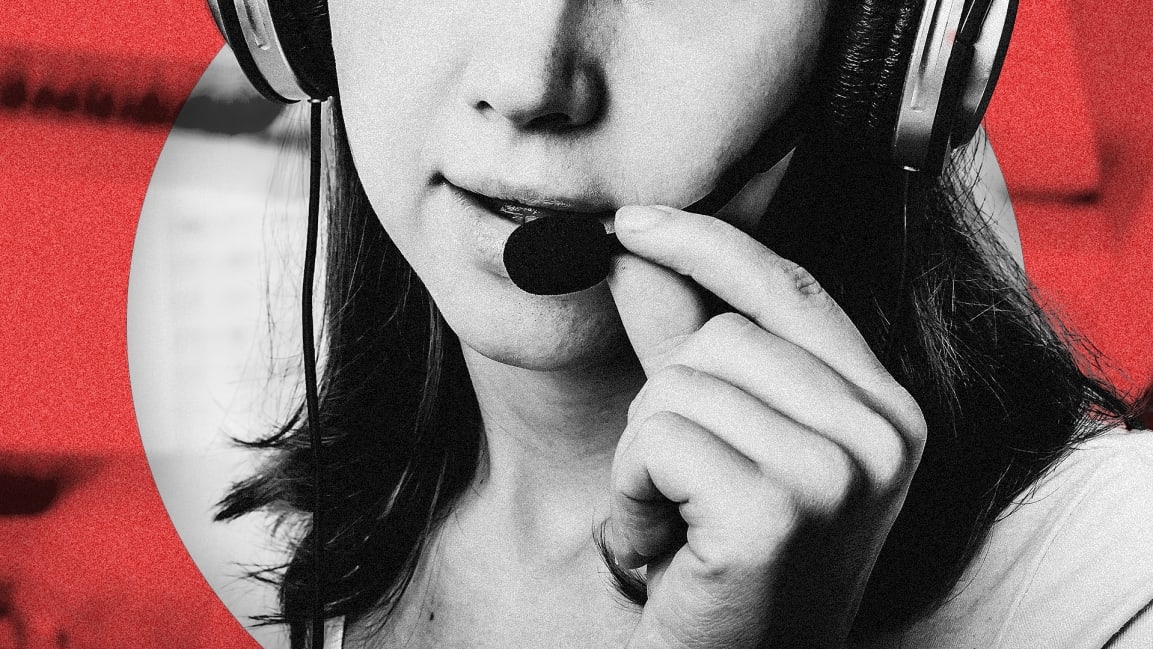Inside the high-stakes world of designing for 911 operators
Anita Pitt sits at her desk, where she speaks with a melodious Texas drawl. She doesn’t convey any particular sense of urgency, and yet, over the past 37 years as the 911 program manager for the Brazos Valley Council of Governments, her entire job has been about conveying urgency. She manages the staff and technology in her region as a small but vital part of the network of 6,100 emergency call centers scattered across the United States. These call centers field 200 million calls a year.
“I think a lot of people’s perception of 911 is what they see on TV,” she says, alluding to glitzy, techie procedurals such as CSI, where dispatchers appear to work in mission control. “Whereas in rural Texas, that’s not always the case. There are a lot of places around the nation that are barely keeping their heads above water with technology.”
911 operator-dispatchers have one of the hardest, most thankless jobs in the world. It takes six months of on-the-job training to become dispatchers. That’s because they have to pick up a phone and talk to someone in the middle of serious trauma—both soothing them and extracting necessary information—while coordinating one or several police, fire, and health departments to arrive on the scene ASAP. Along the way, an operator may be using half a dozen pieces of unrelated software across three to six computer screens, using multiple keyboards, mice, and even foot pedals, while simultaneously manning a radio to connect to help on the ground.
“You really don’t know what kind of call you get, so we have to be prepared for anything,” says Kristi Stamnes, director of Washington County 9-1-1, who works under Pitt. “No one ever calls us on their good days.”
This is the high-stakes world of a 911 call center, a design problem like no other. “It’s an area of our society that’s been vastly underserved by design for its entire existence,” says Lexie Spiro, former director of user experience and research at Motorola Solutions (who recently left for Amazon). Motorola Solutions is the market leader in both radios and emergency software for public safety.
At Motorola, Spiro was part of a small but highly specialized group of designers that focuses on the split-second UX of first response. The company’s software consolidates disparate 911 programs into a single, easy-to-navigate platform. This has earned Motorola more than 3,500 customers for its emergency software—including a $120 million 911 client the company signed last year, the largest contract in its history. Between March and June of last year, COVID-19 more than doubled 911 wait times, from 9 seconds to 25 seconds—with several reports of people being on hold for minutes before reaching a dispatcher as locations reached capacity. The need has never been more pressing—but the reality is that it’s a much bigger problem than software alone can fix.
Expectations versus reality
A well-functioning 911 system is crucial for public safety, but there are few industries with as large a gulf between what the public expects is happening versus what is really happening.
911 call centers are up against all sorts of challenges, which impede their efficiency and capability. They buy software from multiple vendors, which doesn’t necessarily integrate well. Furthermore, most dispatchers have limited funding to upgrade to the latest technologies and can be stuck for up to a decade using older tech. Turnover is quick in the high-stress, low-paid industry, so new employees are constantly being trained in offices that are notoriously understaffed. And while old, inefficient software is problematic for dispatchers, there’s also a natural tension around introducing any change—with its own learning curve—when seconds truly matter. Imagine how infuriating it can be when your favorite app moves a button to a more esoteric spot. Well, know that the pressure of liking a post on social media is lower than a house fire.
People don’t realize all this when they call in. We expect that 911 is often more capable than it is, and we can see that with a technology as simple as location tracking. Which is why one of the first questions of every 911 call is where you’re located.
“911 as an industry needs to try to meet the expectations of citizens,” says Pitt. “They think they can find us on a wireless call, that we automatically know precisely where they are. That’s just not true!”
I was as surprised as anyone to learn that when you call emergency services, they cannot always simply see the perfect GPS location from your phone. Instead, your cellphone carrier will often generalize your location to a cell tower, which could be miles away. (And so dispatchers must often double as investigators, both confirming and narrowing down where a person is.)
This difficulty is starting to change, however. As Pitt explains, six months ago her county upgraded to RapidSOS, which is a platform that can take advantage of more sensors in a caller’s phone to further triangulate location through extra connections such as Bluetooth and Wi-Fi. The Federal Communications Commission is also investing in a new standard that will be able to track the altitude of someone’s phone, meaning they could more easily be spotted in high-rise buildings. But that was delayed with COVID-19 due to the difficulty of sending technicians to test so many spaces.
“People don’t know where they are. They have no clue,” says Pitt. “We’re a society that, we can hit the car and go, and we don’t pay attention to landmarks and things. That is very frustrating for the call taker.”
Once a dispatcher has the address, that data can be sent electronically, along with other notes, to the first responder on the ground. At the same time, dispatchers will hop between the phone and a radio, checking in with the caller and the responder, and double-checking that nothing is lost in translation.
So how do we fix this?
Clearly there’s an educational component for the public that could mitigate our expectations for 911 versus the reality of the service. But what can be done to make the jobs of operators more manageable?
“This piece of the industry is, frankly, looking like the tech industry in the early ’90s,” says Andrew Sinclair, SVP of software at Motorola Solutions. “You’re buying Word from here, Excel from there, and trying to cobble it all together.”
There are no shortages of companies building 911 software, including Omnigo, CentralSquare, Hexagon, and DataTech 911. Much of Motorola’s promise in the industry is to provide a more streamlined experience for call takers, rolling up so many disparate apps into a more singular, cloud-based platform called CommandCentral, which Sinclair positions as something like Microsoft’s Office 365, but for emergencies.
The system has some helpful technologies. Motorola can now use AI to real-time transcribe calls for a dispatcher and sometimes even pull up local camera feeds from the site of an accident, which helps the dispatcher investigate the situation and provide more information to responders. But the biggest advantage may simply be that of workflow, which optimizes the way dispatchers look from one screen to another for information.
Optimizing such chaotic, legacy computer systems is no small feat. One of the biggest challenges of designing for a 911 center is that it is quite difficult to study someone who is working in an emergency situation without disrupting them. While the worker hops between various screens, it can be hard to parse why.
“We can’t just interrupt a 911 call taker and ask, ‘Why did you say what you just said?’ We’d love contextual inquiry, seated next to a call taker, observing their behavior . . . and we are able to ask questions in context about what they’re doing,” says Spiro, former director of user experience and research at Motorola Solutions. “But the reality is you can’t do that in a call center! They’re on an important call!”
Motorola designers participate in job shadowing and listen in on calls. They’ve seen dispatchers conduct CPR over the phone and reach for Post-its to take down information to move it between screens because you can’t copy and paste between two computers. Moments like these can provide a holistic view of the design challenges. But when it comes to eliminating inefficiencies in the system, or figuring out how a particular scenario could be simplified, that gets hard.
“The thing to note here is it’s not that any one of these products is poorly designed,” says Spiro. “It’s that no one has ever looked at what the overall UX is for using all of them at once.”
To get an understanding of workflow across up to 14 different apps on as many as seven screens, Motorola used eye-tracking systems. In any given category of emergency, a dispatcher looks at different screens in different orders. Motorola shows me images of how they began with raw eye-tracking data across four screens but then recognized patterns. These patterns are predictable screen sequences.
I see how a burglary 911 dial leads people to look from a call screen, to a dispatch screen for three steps, and back to a call screen. They never look at the map, perhaps because people in this situation can name their exact address accurately. But an accidental dial is totally different. They begin at the call screen but ping-pong back and forth between dispatching and the map. I’m looking at simple number sequences, but I can already see the narrative shaping up in my brain. While the caller made an error, the operator is still skeptical, and referencing all available information to ensure this person is really as safe as they say they are.

Once Motorola understood these workflows, they considered a new kind of interface. Instead of giving an operator all data all the time, what if they prioritized it better by scenario? They actually handed off-the-clock dispatchers a series of cards with different pieces of data on them and tasked them with designing their own ideal screens. The catch was that, by design, these cards couldn’t all fit onto one screen. They were forcing dispatchers to prioritize information by scenario, which further confirmed and advanced findings from eye tracking.
It all added up to become a more natural directional workflow, according to Motorola. While dispatchers previously darted their eyes in every direction, like a fly exploring a room at random, Motorola designed a case to work its way from left to right. A call comes in on the left, and it’s assigned a card with its main information. As it’s dispatched, the card moves to the middle. And as it’s completed, it moves to the right. This keeps pertinent data flowing like a train, rather than scatted around everywhere.
As for the capabilities described to me by Andrew Sinclair, SVP of software at Motorola Solutions, they don’t sound so far from an episode of CSI at all. But all of that seamless integration requires more buy-in to the Motorola platform—both figuratively and literally. Funding for 911 varies vastly by state, and due to some extremely esoteric policies, funding for the industry has stayed stagnant or even dropped as operational costs have risen over time. It’s a reason that the company actually assists clients in seeking government grants.
“Come September first of this year, I have to decide, can I only afford it for our county or our region. It’s hard for me. Every 911 call is as important as the next,” says Pitt. “That’s what keeps me awake at night. It’s not the calls. It’s the funding. I want to provide the same services for all our counties.”
Fast Company , Read Full Story
(23)



